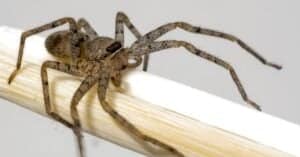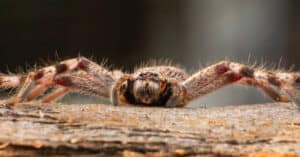Georgia is home to many different plants and animals from black bears to big brown bats. It features both coastal plains and mountain ranges teeming with both unique and common species.
The Peach State is also home to many different kinds of spiders. From venomous black widows to invasive orb weavers, you can find a myriad of spiders in Georgia.
Here is a list of 10 different spiders that you can find throughout the state:
#10: Brown Recluse
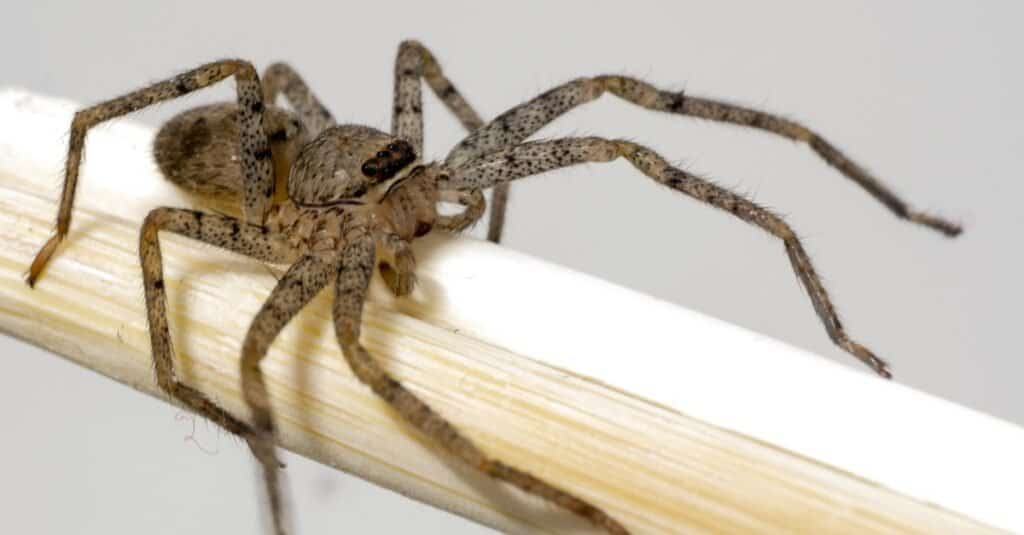
Even though it has extremely dangerous venom, the brown recluse actually has incredibly small fangs compared to most spiders.
©Physics_joe/Shutterstock.com
The brown recluse is one of the most venomous spiders in Georgia. It carries necrotic venom that is capable of causing vomiting, muscle aches, skin necrosis, and in rare circumstances even death. Luckily, it rarely bites people unless backed into a corner, and its bite is normally only fatal to young children or people with weak immune systems.
Most brown recluses measure from 6 and 20 millimeters in length. Their bodies typically range from light brown to dark brown or grey, which is where they get their name.
They possess a dark line coming from the cephalothorax that looks like a violin. Due to this violin-shaped marking, they also go by the names fiddle back spider, brown fiddler, or violin spider.
Brown recluses build asymmetrical webs but does not rely on their webs to catch prey. Instead, they leave their webs at night to actively hunt down insects.
#9: Southern House Spider
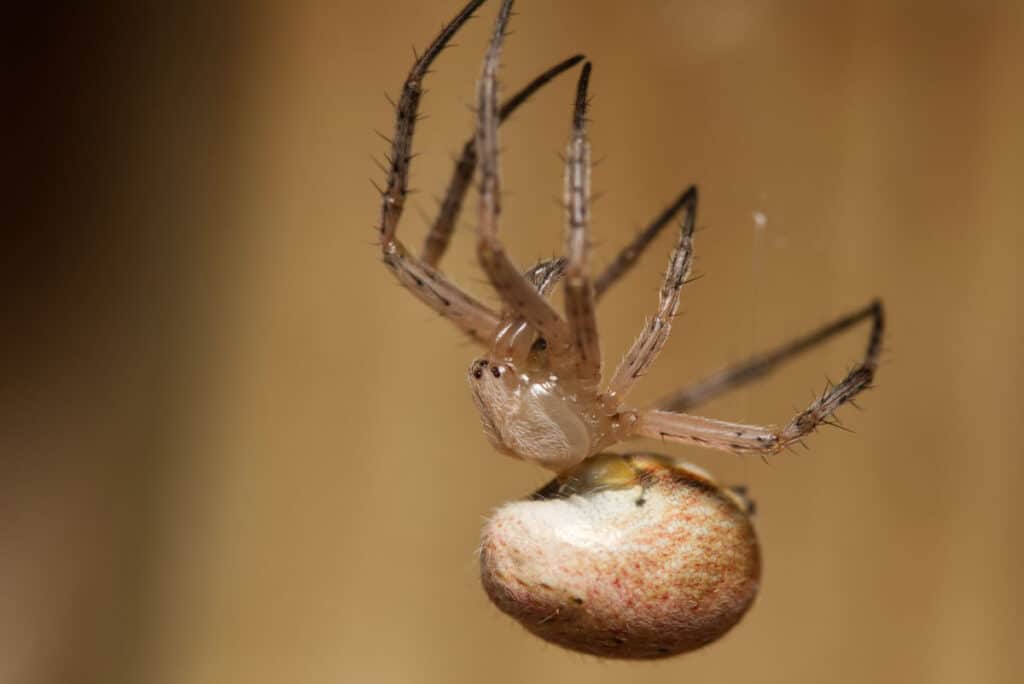
Southern house spiders often get mistaken for brown recluses due to their similar markings
©Kala Stuwe/Shutterstock.com
The southern house spider is a member of the crevice weaver spider family Filistatidae. It is one of the most common spiders in Georgia and is also widely distributed throughout the southern United States. Outside of the United States, you can find it as far south as Argentina.
Southern house spiders often get mistaken for the more dangerous brown recluse due to their similar appearance. That said, you can tell them apart due to the fact that southern house spiders lack the brown recluse’s distinctive violin-shaped marking.
Females typically measure 12 to 18 millimeters long, while males measure 8 to 12 millimeters long. Both sexes appear mostly brown, although females appear darker than males, while males have longer legs.
To catch prey, female southern house spiders build radial-style webs made of non-sticky silk. They construct their webs to entangle prey long enough for the females to deliver a killing bite.
#8: Joro Spider
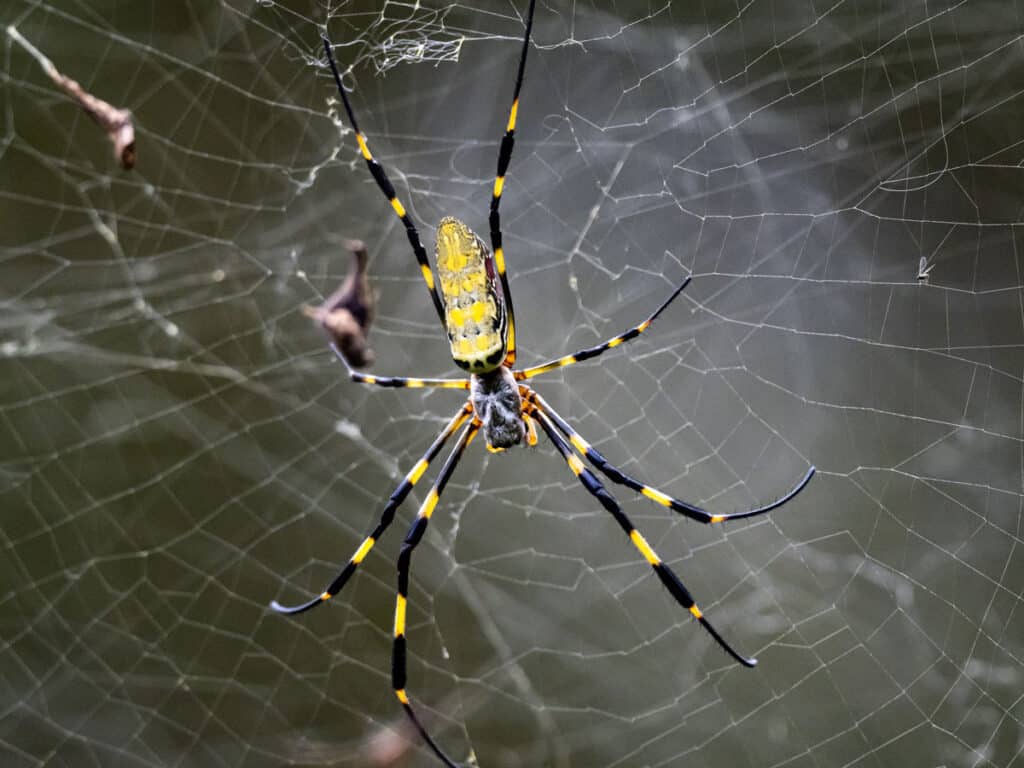
The Joro spider originally hails from East Asia and is now creating a foothold in the southeastern United States
©Dave Hansche/Shutterstock.com
Joro spiders, also known as East Asian Joro spiders, are invasive orb weaver spiders in the genus Trichonephila. While you can find these spiders in Georgia and South Carolina, they are native to several countries in East Asia, including Japan, Korea, Taiwan, and China.
Joro spiders are among the biggest spiders in Georgia. Females measure between 17 and 25 millimeters long, while males measure 7 to 10 millimeters in length. They have yellow and dark blue stripes and a red patch near the rear of their abdomens.
Joro spiders spin silk that is considerably stronger than the silk created by most other spiders. Additionally, their webs look different compared to the webs of other orb weavers, consisting of a central orb with irregular layers behind and in front of the orb. Although they rarely act aggressively towards humans, their bite is quite painful.
#7: Southeastern Wandering Spider
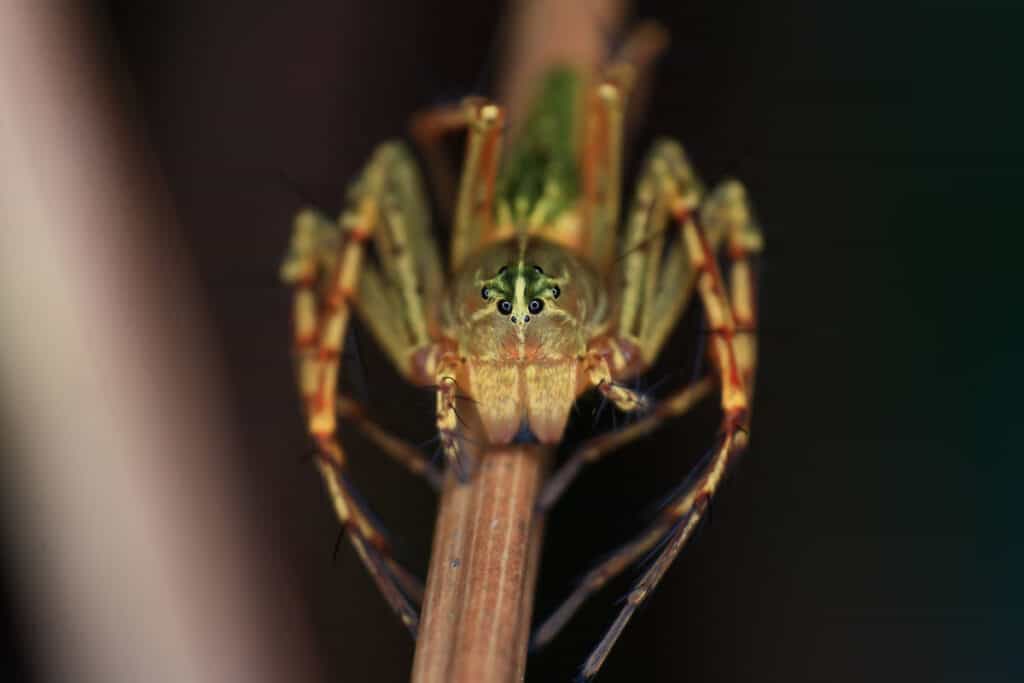
The southeastern wandering spider actively hunts for prey using ambush tactics
©Firdaus Khaled/Shutterstock.com
The southeastern wandering spider is a member of the wandering spider family Ctenidae. You can find these spiders in Georgia as well as throughout the southern United States.
Southeastern wandering spiders come in a wide range of sizes, measuring anywhere from 5 to 40 millimeters long. People often confuse them for wolf spiders due to their similar appearance. They possess long, multi-jointed legs that curl upwards.
Their bodies and legs are mostly light orange or tan with dark mottling, and they have a light strip down the center of their carapaces and abdomens.
Southeastern wandering spiders do not build webs and instead actively hunt prey using ambush tactics. When not hunting, they rest in burrows on the ground and on plants. Although they are poisonous, their bite is not considered medically significant.
#6: Twin-Flagged Jumping Spider

The twin-flagged jumping spider gets its name from the 2 pennant-shaped markings on its cephalothorax
©Sari ONeal/Shutterstock.com
Anasaitis canosa, or the twin-flagged jumping spider, is a small jumping spider in the family of Salticidae. In addition to finding these spiders in Georgia, you can also spot them in states along the Gulf of Mexico.
Most specimens range between 5 and 6 millimeters in length, with females measuring only slightly larger than males. They get their name from the two flag-shaped markings on the bottom side of their cephalothorax.
As is common with other members of the genus Anasaitis, they possess shiny scales that range in hue from white to green to pink on their abdomens and cephalothorax. Meanwhile, their carapaces are mostly black and feature two white dots.
Twin-flagged jumping spiders rely on their keen eyesight and agility to catch prey. When hunting ants, they will directly face an ant and then leap onto their target to puncture its head or thorax with their chelicerae.
#5: White-Banded Fishing Spider
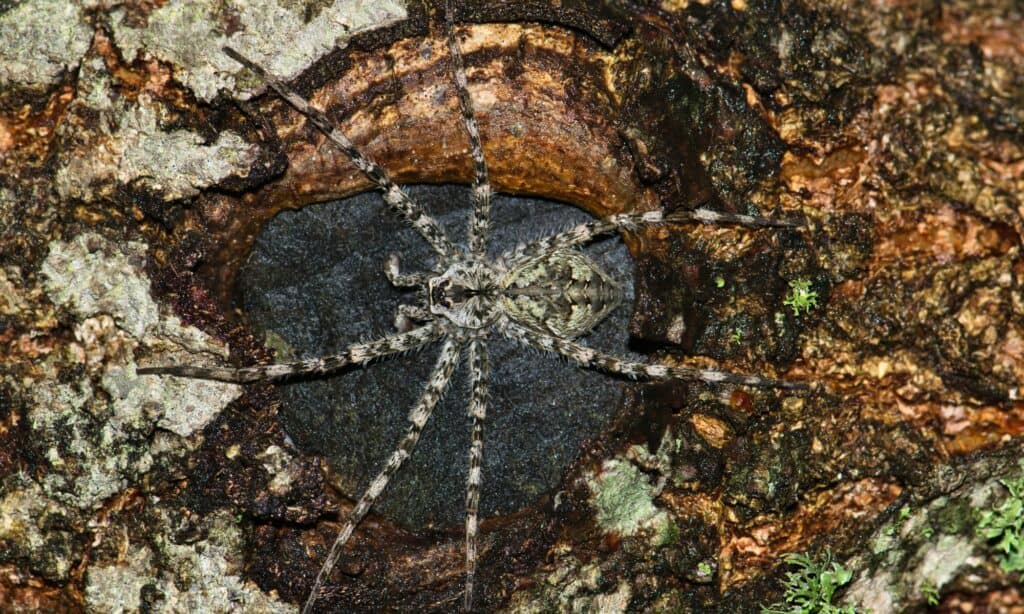
The white-banded fishing spider can create an air pocket under its abdomen that allows it to dive under the water to catch prey.
©iStock.com/Brett_Hondow
The white-banded fishing spider is a member of the family Pisauridae, or nursery webs spiders. It is found throughout the United States, particularly near streams and ponds.
Female white-banded fishing spiders average around 23 millimeters long, while males average around 18 millimeters. Their color varies, although most appear brown while some look light green with dark mottling. They get their name from the white band that runs across the space below their eyes and around their jaws.
White-banded fishing spiders are one of the few spiders in Georgia that hunt small vertebrates. In addition to catching insects, they will also hunt for tadpoles or small fish under the surface of the water. They possess special hairs that repel water, allowing them to run across the surface of the water, and can trap air in a bubble on their abdomens so they can dive beneath the surface.
#4. Ravine Trapdoor Spider

The ravine trapdoor spider sports a unique-looking disk on the back of its abdomen that is used to block the hole of its burrow
©Venus Saksongmuang/Shutterstock.com
The ravine trapdoor spider, Cycloscosmia truncata, is one of the rarest, most unique-looking spiders in Georgia. As its name implies, it often chooses to build its burrow in ravines. It is a member of the genus Cyclocosmia, which in Greek translates to “adorned with a circle.”
Female ravine trapdoor spiders measure around 28 millimeters long, with a disk around 16 millimeters wide. Their scientific name refers to their distinctive disk-shaped abdomen.
Their disks consist of a circle of grooves along the outside that comes together to form an irregular shape in the middle of the disk. While the rest of their body is a glossy light or dark brown, the disk is light grey.
Ravine trapdoor spiders use the disk on their abdomens to block their predators, thereby protecting them from predators. Similarly, they use sit-and-wait tactics to prey on insects that venture too close to their burrows.
#3. Spiny-Backed Orb Weaver
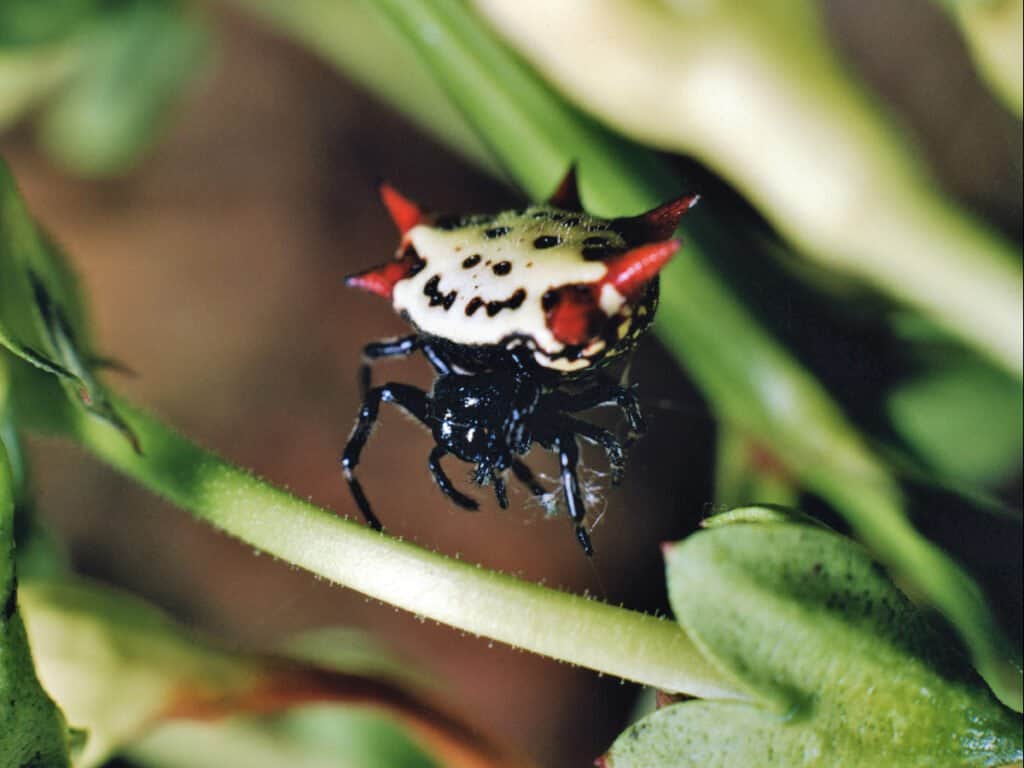
The spiny-backed orb weaver is also called the star spider due to its spiky appearance
©iStock.com/Weber
The spiny-back orb weaver is a member of the orb weaver family Araneidae. It’s one of the most unique orb weaver spiders in Georgia, as it features a shell-like abdomen with prominent spikes. It is widely distributed throughout North and South America as well as parts of Central Asia.
Female spiny-backed orb weavers measure 5 to 9 millimeters long, with males measuring 2-3 millimeters long. Additionally, only the females sport the 6 spines along the abdomen from which the species gets its name. Typically, females that have a white upper abdomen sport red or black spines, although different color variations exist. Instead of spines, males sport several stubby projections and typically have grey abdomens with white spots.
Spiny-backed orb weavers like to build their webs in lightly wooded areas in regions with warm, wet climates. They prey on many garden pests and their bite poses little threat to humans.
#2: American Green Crab Spider

The American green
crab spider
features extremely long front legs designed to help it catch prey
©iStock.com/Del Henderson Jr
American green crab spiders belong to the crab spider family Thomisidae. You can find these spiders in Georgia as well as throughout the southeastern United States.
The American green crab spider gets its name from its lime green color and its habit of walking sideways like a crab. Its greenish color allows it to blend in with flowers and grasses, which helps it to ambush prey and avoid predators.
Most specimens measure between 3 and 7 millimeters long and sport extremely long front legs designed to help them grab prey. While they appear almost uniformly green, they feature a thin red line surrounding the front part of their abdomens.
American green crab spiders hunt by waiting on plants and flowers for insects coming to drink nectar or collect pollen. Due to their small size, their bite is not considered medically significant and poses little threat to humans.
#1. Dotted Wolf Spider
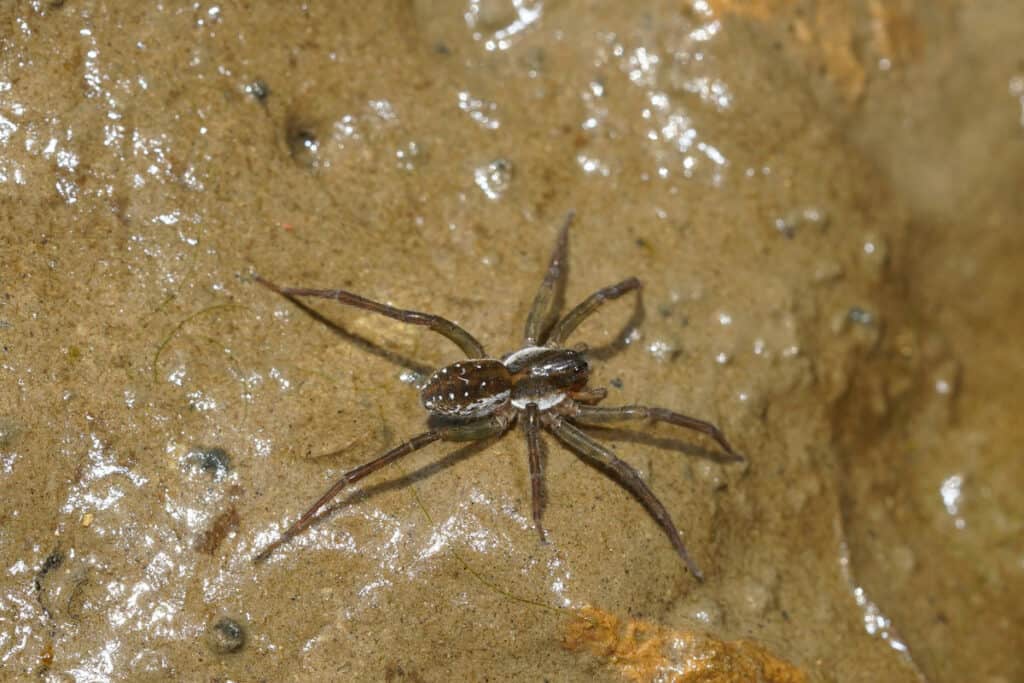
The dotted wolf spider is often mistaken for the rabid wolf spider due to their similar appearance
©HWall/Shutterstock.com
The dotted wolf spider, rabidosa punctulata, often gets mistaken for its cousin, the rabid wolf spider. Both belong to the family Lycosidae, and you can find both of these spiders in Georgia. That said, the dotted wolf spider possesses a number of distinguishing characteristics.
They are distinguishable thanks to the distinctive dots located on the underside of their abdomens. Aside from the dots, they also sport a solid brown stripe down the middle of their abdomens. Female dotted wolf spiders typically measure 15 millimeters long, while males measure around 13 millimeters.
Like other wolf spiders, female dotted wolf spiders will carry their eggs attached to the spinnerets. They hunt actively instead of using webs to catch prey and rely on their speed and strength to overwhelm their targets. Despite their size, their bite is not considered dangerous to humans.
What Animals Live in Georgia?
Georgia is home to many creatures such as the armadillo, moles, beavers, and rats.
Additionally, Georgia is home to a variety of wildlife, including:
- Mammals: White-tailed deer, black bear, coyote, raccoon, skunk, squirrel, opossum
- Birds: Bald eagle, wild turkey, red-tailed hawk, American robin, blue jay
- Reptiles: Gopher tortoise, eastern box turtle, copperhead snake, the cottonmouth snake, rattlesnake
- Fish: Largemouth bass, catfish, crappie, bream
- Amphibians: Green treefrog, bullfrog, American toad
This is not an exhaustive list, and there may be other species found in Georgia.
The photo featured at the top of this post is © Pong Wira/Shutterstock.com
Thank you for reading! Have some feedback for us? Contact the AZ Animals editorial team.





